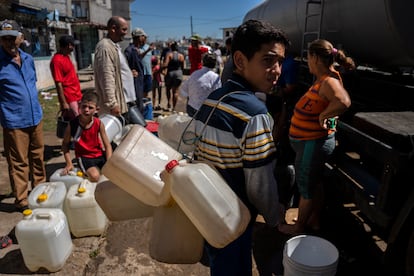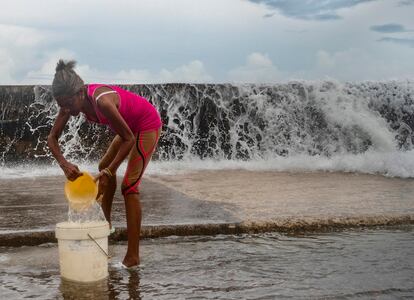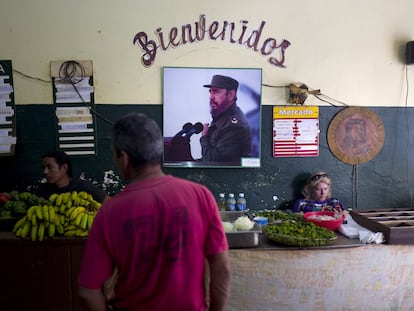The latest protests in Cuba are about thirst: Over 600,000 people live without drinking water
The Cuban government has acknowledged that the problem is due to numerous leaks, broken pumping equipment and constant power outages on the island. But no solution seems forthcoming

On Tuesday night, residents of La Rosita neighborhood in San Miguel del Padrón, a municipality on the outskirts of Havana, took to the streets after more than two weeks without drinking water. Badiela Ayala was there, part of the crowd that banged on pots, shouted “Turn the water on!” and stopped traffic in the middle of Calzada de Güines. “People from the government came to the scene,” says Ayala. “They brought us water trucks, thank God, because we haven’t had any for more than 17 days.” To date, no one has solved the root problem: when the water that the government sent to quell the protests on the streets runs out, there will be a shortage of water again for drinking, cooking, washing clothes and bathing. “What will we do if that happens? Well, the same thing we did now,” says Ayala. “We will go out into the streets again.”
The water crisis in Cuba did not begin yesterday, but the country’s overall deterioration, the impossibility of adequate pipeline maintenance and the shortage of fuel have clearly exacerbated the problem, since the water management sector is the second largest consumer of electricity in the country. Cuban authorities have acknowledged that more than 600,000 people suffer from a lack of water. José Antonio Hernández, president of the Business Group for Water and Sanitation, told the official press that in Havana alone some 130,000 clients are affected by the water shortage, and that there are several provinces in the interior of the country with thousands of clients without service.
The official listed as causes the breakdowns of pumping equipment and the constant power outages that Cubans have been dealing with for some time, and which have forced them to stage public protests on more than one occasion. Another problem is the so-called leaks. Hernández himself said that, at the end of 2023, there were about 2,000 of these water leaks in Havana that remained unrepaired “for days and months.”
The problem, however, appears to be greater than what the authorities are willing to admit. A study by the Cuban Observatory of Human Rights (OCDH) states that in reality there are many more people living without access to drinking water in the country. “We question the figure provided by the government. Our study on social rights in 2023 showed that 17% of those surveyed did not have drinking water services. This is approximately 663,000 homes, so we could be talking about 1.9 million people, considering three people per household,” says Yaxys Cires, director of strategies for the organization. “But we are also concerned about another significant number of households, the 27% that only receive water less than four days a week, and the 40% that receive it between four and six days. The majority of the population does not have water in a stable and permanent manner.”

A “desperate” situation
In western Cuba, in the province of Pinar del Río, Lismary Mariño says she has been without water for more than a month. She has 55-liter buckets for cooking. When they are empty, she refills them in other areas near her town. She also has two small tanks on the roof of her house that guarantee her water for 15 days, and which are almost empty by now. “The truth is that this is a desperate situation,” says Mariño. “I have a small child, my neighbors also have children and elderly people in their care. There are so many things that afflict us.”
The problem, which officials have described as “a very complex situation,” does not seem to have a clear solution, or at least not a short-term one. This was made clear by Antonio Rodríguez Rodríguez, the president of the National Institute of Hydraulic Resources (INRH), on the day that President Miguel Díaz-Canel asked him when the water shortage would be resolved. “Telling you a date when we will be able to solve the problems would not be fair on my part,” said Rodríguez, being as honest as he could. “We hope that, being realistic and based on our current pace, we can have a better situation next year, although that does not mean that we are going to solve all the problems with leaks, obstructions, water supply and others.”
Last year, the president of the INRH said that 478 population centers had a total or partial lack of water supply; that some 2.7 million people received water every three or more days, and that some 475,000 Cubans received water via tanker trucks. Although the government has tried to solve the water problem by sending tankers, they often cannot be transported due to the availability of fuel or tires. An entire informal market has also been created, where Cubans who can afford it pay up to 8,000 pesos ($25) for one of these tanker trucks.
The constant complaints about the poor maintenance of the water management system and the proliferation of sewage in the Cuban capital are also blamed on the poor work of Aguas de La Habana, the company in charge of the water, sewage and sanitation services. However, there are very few people who want to work for the state company today. Rodríguez told the official press that “valuable workers and specialists decided to leave the sector in search of higher salaries.”
Karen Isasi, a resident of San Miguel del Padrón who has been without water for two weeks, went to the offices of Aguas de La Habana to get a response, and was told that the director was on vacation. Then another employee wrote down the complaints and told her that she would had to wait. “Four small children live in my house and it is a headache to be without water,” she says. “I have to carry water from the houses of neighbors who are doing me the favor so that I can cook and do other chores.”
Isasi’s neighbors also took to the streets a few days ago to demand a response. They were not the only ones. Recently, other very localized demonstrations have been reported demanding a solution to the lack of water: residents of Centro Habana stopped traffic on Reina Street; others from Villa Clara, in the center of the island, joined in shouting “we want water” after two months of drought; quite a few mothers with children, accompanied by buckets and plastic tanks, have protested in public. The government, on several of these occasions, has deployed its police officers, worked to calm down the civil unrest, sent water trucks to solve the immediate problem and promised a solution that, for the moment, does not seem to be forthcoming.
Sign up for our weekly newsletter to get more English-language news coverage from EL PAÍS USA Edition
Tu suscripción se está usando en otro dispositivo
¿Quieres añadir otro usuario a tu suscripción?
Si continúas leyendo en este dispositivo, no se podrá leer en el otro.
FlechaTu suscripción se está usando en otro dispositivo y solo puedes acceder a EL PAÍS desde un dispositivo a la vez.
Si quieres compartir tu cuenta, cambia tu suscripción a la modalidad Premium, así podrás añadir otro usuario. Cada uno accederá con su propia cuenta de email, lo que os permitirá personalizar vuestra experiencia en EL PAÍS.
¿Tienes una suscripción de empresa? Accede aquí para contratar más cuentas.
En el caso de no saber quién está usando tu cuenta, te recomendamos cambiar tu contraseña aquí.
Si decides continuar compartiendo tu cuenta, este mensaje se mostrará en tu dispositivo y en el de la otra persona que está usando tu cuenta de forma indefinida, afectando a tu experiencia de lectura. Puedes consultar aquí los términos y condiciones de la suscripción digital.
More information
Archived In
Últimas noticias
Most viewed
- Sinaloa Cartel war is taking its toll on Los Chapitos
- Reinhard Genzel, Nobel laureate in physics: ‘One-minute videos will never give you the truth’
- Oona Chaplin: ‘I told James Cameron that I was living in a treehouse and starting a permaculture project with a friend’
- Why the price of coffee has skyrocketed: from Brazilian plantations to specialty coffee houses
- David King, chemist: ‘There are scientists studying how to cool the planet; nobody should stop these experiments from happening’











































